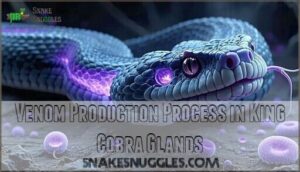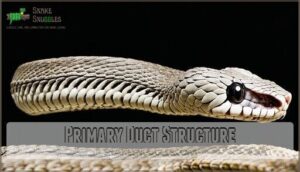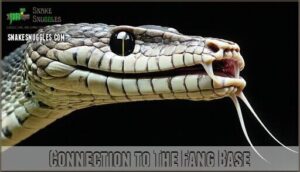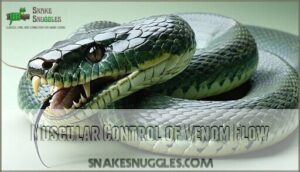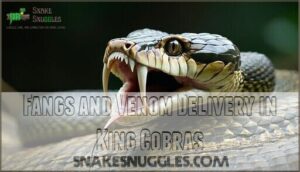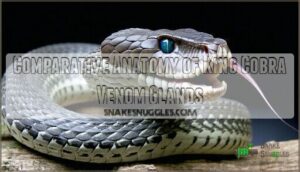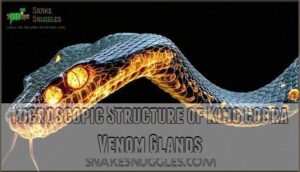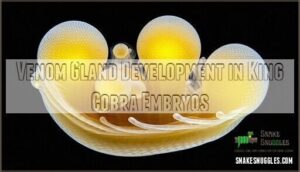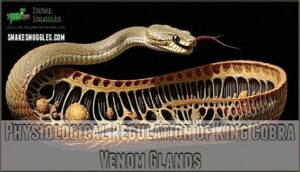This site is supported by our readers. We may earn a commission, at no cost to you, if you purchase through links.
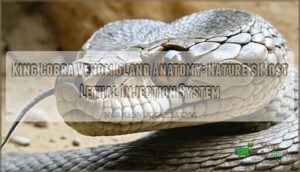 The king cobra venom gland anatomy features massive paired glands positioned behind each eye, stretching nearly one-third of the skull’s length.
The king cobra venom gland anatomy features massive paired glands positioned behind each eye, stretching nearly one-third of the skull’s length.
You’ll find these sac-like structures wrapped in connective tissue, containing specialized secretory cells that produce deadly neurotoxins.
The glands connect to hollow fangs through muscular ducts, allowing precise venom delivery.
Unlike other snakes, king cobras possess remarkably large venom reservoirs—each gland can hold up to 7 milliliters of venom, enough to kill an elephant.
The glandular tissue consists of secretory epithelium surrounded by smooth muscle that contracts during strikes.
Understanding this biological marvel reveals how evolution crafted the perfect chemical weapon.
Table Of Contents
- Key Takeaways
- King Cobra Venom Gland Location and Structure
- Composition of King Cobra Venom Gland Tissue
- Venom Production Process in King Cobra Glands
- King Cobra Venom Duct System Anatomy
- Fangs and Venom Delivery in King Cobras
- Comparative Anatomy of King Cobra Venom Glands
- Microscopic Structure of King Cobra Venom Glands
- Venom Gland Development in King Cobra Embryos
- Physiological Regulation of King Cobra Venom Glands
- King Cobra Venom Gland Imaging Techniques
- Frequently Asked Questions (FAQs)
- What is the structure of the snake venom gland?
- Which snake has the largest venom glands in the world?
- Where are venom glands located?
- What does the King Cobra venom contain?
- What is the anatomy of the snake venom gland?
- Where is the venom gland on a cobra?
- Can you remove venom glands from a cobra?
- How does king cobra venom compare to other snake venoms?
- Can king cobras control the amount of venom they inject?
- Do king cobras ever run out of venom?
- Conclusion
Key Takeaways
- You’ll find king cobra venom glands are massive organs stretching up to one-sixth of the snake’s body length, positioned behind each eye like nature’s biological weapons cache.
- You’re looking at specialized secretory cells that work like microscopic factories, constantly manufacturing deadly neurotoxins through complex protein synthesis and storage mechanisms.
- You’ll discover these glands can hold up to 7 milliliters of venom – enough lethal cocktail to kill an elephant – making them the largest venom storage system among venomous snakes.
- You’re dealing with a precision delivery system where muscular contractions squeeze venom through specialized ducts to hollow fangs, allowing cobras to control exactly how much poison they inject.
King Cobra Venom Gland Location and Structure
You’ll find the king cobra’s venom glands positioned behind each eye, hugging the skull’s contours like nature’s own biological weapons cache.
Nature’s biological venom factories positioned strategically behind deadly eyes, ready to unleash lethal precision.
These elongated, almond-shaped organs can stretch up to one-sixth of the snake’s body length, making them substantially larger than the venom apparatus found in most other venomous species.
Position Relative to The Skull
How do these deadly venom glands position themselves within the king cobra’s skull?
You’ll find them hugging the skull’s contours behind each eye, perfectly positioned for maximum cranial efficiency. The glands attach laterally and posteriorly to the eye sockets, creating an ideal venom placement system.
Key positioning features:
- Skull Attachment – Glands anchor securely to maxillary and temporal bones using connective tissue
- Gland Orientation – Elongated shape follows the skull’s natural curves for space efficiency
- Cranial Position – Strategic placement maximizes head anatomy without compromising brain space
Size and Shape of The Venom Gland
You’ll be amazed by the king cobra’s venom gland dimensions – these biological weapons stretch up to one-sixth of the snake’s entire body length.
Picture an elongated almond-shaped factory hugging your skull’s contours, that’s the gland morphology we’re dealing with.
This impressive venom capacity means a single bite can store enough toxin to drop an elephant, making the venom gland structure perfectly engineered for maximum lethality.
Anatomical Differences From Other Snake Species
King cobra venom gland anatomy represents remarkable anatomical adaptation compared to other venomous snakes.
While most elapids possess compact glands, king cobras sport massive structures reaching one-sixth their body length—that’s species variation on steroids.
This gland structure evolution reflects specialized venom evolution for dispatching large prey.
Their snake venom anatomy differs dramatically from vipers too, whose smaller salivary-derived glands pale beside these pancreatic-origin powerhouses.
Snake comparison studies reveal reptile venom glands reaching unprecedented proportions in ophiophagus hannah.
The king cobra’s venom system is a prime example of dynamic gene evolution that has led to its unique characteristics.
Connective Tissue Surrounding The Gland
The connective tissue surrounding the king cobra’s venom gland acts like nature’s own protective bubble wrap.
These fibrous layers provide essential gland stability and tissue support, creating a cellular matrix that shields the delicate venom-producing structures.
This muscular layer works alongside the blood supply to maintain proper venom gland anatomy, ensuring the gland protection needed for ideal function while anchoring the venom gland location securely within the skull’s framework.
The king cobra’s venom production is influenced by its venom gland function.
Composition of King Cobra Venom Gland Tissue
When you examine a king cobra’s venom gland under the microscope, you’ll discover it’s basically a biological factory with four distinct tissue layers working together.
Each component—from the poison-producing cells lining the interior to the muscle fibers that squeeze out the deadly cocktail—plays a vital role in creating nature’s most efficient lethal injection system.
Secretory Epithelium Structure
Picture the secretory epithelium as nature’s chemical laboratory, where specialized secretory cells manufacture lethal compounds.
This cellular layer forms the glandular tissue’s inner lining, orchestrating venom synthesis through precise epithelium function.
These microscopic factories work around the clock, producing the king cobra’s notorious cocktail.
The venom production process relies entirely on this remarkable tissue, making it the cornerstone of venom gland anatomy and venom gland function.
Muscular Layer Characteristics
Beyond the secretory epithelium lies the muscular layer – your cobra’s biological pressure pump. This muscle tissue wraps around the venom gland like a powerful sleeve, ready to release contractile forces that’ll make your head spin.
Here’s what makes this muscular control system absolutely incredible:
- Fiber structure arranged in precise circular patterns for maximum squeeze
- Lightning-fast contractions triggered by neural signals during strikes
- Venom expulsion powered by coordinated muscle compression
- Pressure generation comparable to hydraulic systems
- Recovery time allowing rapid follow-up strikes
When your king cobra strikes, these muscles don’t mess around – they contract with surgical precision, forcing venom through the duct system with enough pressure to guarantee delivery.
Blood Supply to The Venom Gland
Arterial branches from the external carotid artery create an extensive capillary network throughout the king cobra’s venom gland, delivering oxygen supply and nutrient delivery for intense venom production.
This robust blood supply supports the gland’s massive metabolic demands—think of it as a high-performance fuel system powering nature’s most efficient toxin factory, ensuring continuous venom irrigation.
The venom production process involves complex snake venom components that contribute to its lethal effects.
Nerve Innervation of The Gland
Neural networks control your king cobra’s venom production through intricate nerve innervation patterns.
Sympathetic and parasympathetic fibers regulate gland stimulation, triggering neural signaling pathways that activate the secretory epithelium.
This nerve control system manages venom regulation by responding to stress hormones and environmental cues, ensuring the venom production process operates efficiently when the snake needs to defend itself or capture prey.
The king cobra’s venom gland utilizes complex venom production mechanisms to optimize its lethal chemistry and ensure effective defense mechanisms.
Venom Production Process in King Cobra Glands
When you examine the king cobra’s venom production system, you’ll discover specialized secretory cells working like microscopic factories to synthesize lethal toxin cocktails.
These cellular assembly lines operate through tightly regulated biochemical processes that transform harmless proteins into some of nature’s most potent neurotoxins.
Cellular Mechanisms of Venom Synthesis
Specialized venom-producing cells within the secretory epithelium act like microscopic factories, constantly manufacturing deadly toxins.
Through complex molecular mechanisms, these cells express specific toxin production genes, synthesizing proteins that make king cobra venom so lethal.
The cellular biology behind venom synthesis involves ribosomes working overtime, producing enzymes and neurotoxins.
It’s remarkable how venom gland anatomy supports this intricate gene expression process, creating nature’s most efficient poison laboratory.
Storage of Venom Components
How effectively does your king cobra store its lethal arsenal?
Once synthesized, venom components require sophisticated storage within specialized venom reservoirs. The king cobra’s alveolar storage system represents nature’s most efficient toxic compound warehousing solution, ensuring maximum potency delivery.
- Venom vesicles function as microscopic storage containers within secretory cells
- Alveolar storage chambers maintain ideal venom composition through controlled environments
- Secretory cells create layered networks that preserve venom integrity until deployment
Regulation of Venom Production
Your king cobra’s venom production operates like a high-tech factory with multiple quality control systems.
Hormone control and neural signals orchestrate venom synthesis by regulating gene expression patterns.
Environmental triggers adjust toxicity levels based on prey encounters and seasonal demands.
| Regulatory Factor | Function |
|---|---|
| Transcription Factors | Control venom gene activation |
| Neural Innervation | Triggers rapid venom release |
| Hormonal Cycles | Modulates production rates |
| Environmental Cues | Adjusts synthesis timing |
Venom gland regulation involves sophisticated feedback loops that optimize venom gland development and efficiency.
This venom gland evolution guarantees your cobra’s venom gland anatomy maintains perfect chemical balance for maximum lethality.
Venom Maturation Within The Gland
Once venom production reaches its peak, you’ll find the real magic happens during maturation.
Venom enzymes undergo protein folding within specialized vesicles, transforming raw compounds into lethal weapons. This maturation process cranks up venom potency through enzymatic reactions that’d make a biochemist jealous.
Here’s how toxic compounds mature in the gland:
- Protein Folding – Raw proteins twist into their active, deadly configurations
- Enzymatic Processing – Specific enzymes cleave and modify toxin precursors
- pH Adjustment – Acidic conditions optimize toxin stability and activity
- Concentration Gradients – Water removal concentrates the final venom cocktail
- Quality Control – Cellular mechanisms eliminate defective toxin molecules
King Cobra Venom Duct System Anatomy
You’ll discover how the king cobra’s venom delivery system relies on an intricate network of ducts that transport deadly neurotoxins from storage to fangs with remarkable efficiency.
This specialized plumbing system connects massive venom glands to hollow fangs through primary channels and secondary branches, all controlled by precise muscular contractions.
These muscular contractions determine whether you’re facing a warning bite or a lethal injection, highlighting the complexity and potential danger of the king cobra’s venom delivery system, which is made possible by its efficient and specialized plumbing system.
Primary Duct Structure
The cobra’s primary duct serves as nature’s precision delivery system, channeling lethal venom from gland to fang with remarkable efficiency.
This tubular conduit demonstrates extraordinary duct formation through evolutionary refinement. The duct anatomy features specialized adaptations that optimize venom flow during the secretion process, establishing a key gland connection between storage and delivery systems.
The primary duct’s sophisticated design includes these remarkable features:
- Reinforced muscular walls that contract rhythmically during venom ejection process
- Internal ridge patterns that create turbulent flow for enhanced mixing
- Pressure-sensitive valves preventing backflow during fang replacement cycles
- Elastic connective tissue allowing expansion under high-pressure conditions
- Specialized epithelial cells that fine-tune venom composition during transport
This venom duct system represents millions of years of venom gland development, creating an anatomical masterpiece that guarantees deadly accuracy when needed.
Secondary Duct Branches
Branching out from the primary duct, you’ll discover an intricate duct network that resembles nature’s plumbing masterpiece. These secondary branches create sophisticated branching patterns throughout the venom gland anatomy, with each pathway serving a specific purpose in venom delivery.
The duct diameter varies substantially – main branches measure roughly 0.5 millimeters while smaller collecting ducts shrink to microscopic proportions. This variation optimizes fluid dynamics, ensuring smooth venom flow from production sites to storage areas.
The king cobra venomous system’s branching architecture allows simultaneous venom collection from multiple secretory regions. Like tributaries feeding a river, these secondary ducts gather toxins efficiently.
This remarkable venom duct system demonstrates how venom gland development has perfected distribution networks over millions of years of evolution, showcasing a highly efficient system that is a result of millions of years of evolution.
Connection to The Fang Base
At the terminal end of this sophisticated Duct System, you’ll find where precision engineering meets deadly efficiency.
The Fang Base serves as the critical junction where venom shifts from storage to delivery:
- Sealed Connection – Venom gland anatomy creates an airtight seal preventing leakage
- Direct Pathway – Duct terminates precisely at each Fang Base for ideal Venom Flow
- Backup Ready – Fang Replacement doesn’t interrupt the Venom Delivery connection
- Pressure Transfer – Venom Ejection Process relies on this seamless Fang Tip pathway
Muscular Control of Venom Flow
Beyond the duct connection lies a sophisticated pressure system.
Muscle contraction around the venom gland creates precise venom pressure control. The compressor muscle acts like a biological syringe, squeezing venom through ducts with remarkable flow regulation.
This muscular control coordinates with fang movement and bite force to deliver exact doses.
Gland contractions can release drops or deadly floods, making venom delivery incredibly efficient and lethal.
Fangs and Venom Delivery in King Cobras
You’ll discover how the king cobra’s fangs transform from simple teeth into precision venom delivery systems through their unique tubular design and muscular ejection mechanism.
These hollow, fixed fangs work like hypodermic needles, channeling lethal neurotoxins directly into prey through specialized venom canals that connect seamlessly to the massive venom glands.
Fang Structure and Attachment
Anyone examining a king cobra’s fang structure discovers nature’s perfect hypodermic needle system.
These hollow fangs aren’t retractable like vipers – they’re permanently fixed to the maxillary bones in an upright position. The tooth attachment creates an incredibly stable platform for venom delivery.
Here’s what makes their bite mechanism so deadly:
- Hollow tubular fangs – perfectly engineered for venom flow
- Rigid maxillary attachment – guarantees precise strike accuracy
- Specialized fang replacement – backup teeth ready when needed
- Optimized length – up to 0.5 inches for deep penetration
This fang anatomy represents millions of years of evolutionary refinement, creating the ultimate venom ejection system that makes king cobra venom so devastatingly effective.
Venom Canal Anatomy
The venom canal functions as nature’s precision delivery system, running through each hollow fang like a microscopic highway.
This tubular structure maintains consistent canal structure throughout its length, ensuring ideal venom flow from the duct anatomy connection to the fang tips.
The venom path features smooth interior walls that minimize resistance, allowing the king cobra venom to travel efficiently.
This snake venom system represents evolutionary perfection in venom delivery mechanisms.
Fang Replacement Mechanism
Remarkably, king cobras maintain up to eight replacement fangs in various developmental stages.
This sequential Fang Regeneration system guarantees continuous Venom Delivery capability through alternating sockets.
When functional fangs wear out, replacement fangs ankylose before old ones shed, preventing gaps in Snake Dentition.
This sophisticated Tooth Replacement mechanism synchronizes with shedding cycles, maintaining lethal efficiency through seamless Fang Morphology shifts.
Venom Ejection Process
Once fangs position properly, muscular contractions around the venom glands trigger rapid venom expulsion.
This delivery mechanism operates like nature’s hydraulic press—muscles squeeze the glands, forcing venom through ducts with incredible pressure.
Fang movement coordinates with muscle contraction to optimize venom flow.
The king cobra controls this venom ejection process precisely, regulating volume from a warning nip to a full lethal dose.
Venom delivery happens in milliseconds, making escape nearly impossible.
Comparative Anatomy of King Cobra Venom Glands
When you examine king cobra venom glands alongside other elapid species, you’ll discover remarkable anatomical distinctions that make these serpents nature’s most efficient venom delivery system.
King cobras possess nature’s most oversized biological weapons—venom glands stretching up to one-sixth their body length.
The king cobra’s glands dwarf those of its relatives, reaching up to one-sixth of the snake’s total body length—a proportion that’d be like humans carrying briefcase-sized organs behind their ears, which is a remarkable anatomical feature, making them nature’s most efficient venom delivery system.
Differences From Other Elapid Snakes
While king cobras share the elapid family tree with their relatives, their venom gland anatomy sets them apart through remarkable evolutionary adaptations.
These serpents have developed specialized features that make their venom delivery system exceptionally efficient compared to other elapid snakes.
Key differences in king cobra venom gland anatomy:
- Massive gland size – Up to 1/6 of total body length, dwarfing other elapids’ proportions
- Enhanced duct complexity – More sophisticated branching network for precise venom flow control
- Specialized muscle arrangement – Stronger contractile tissues enable forceful, controlled venom ejection during strikes
Unique Features of King Cobra Glands
Here’s the enhanced king cobra venom gland anatomy content:
Discover what makes king cobra venom glands nature’s ultimate biological weapon.
These supersized glands showcase remarkable gland specialization, holding up to 7ml of venom – enough to kill 20 adults.
Their venom gland efficiency stems from unique cobra adaptations: enlarged storage capacity, enhanced venom gland complexity, and optimized gland evolution for maximum toxicity levels and venom efficiency.
Evolutionary Adaptations in Venom Gland Anatomy
Through millions of years, king cobra venom gland anatomy has undergone remarkable evolutionary adaptations.
These lethal injection systems evolved from pancreatic secretory networks, sharing ancestral regulatory components like miR-375 expression patterns. The glands developed extraordinary venom efficiency through specialized anatomical features that optimize toxin delivery.
Key evolutionary adaptations include:
- Gland Evolution: Massive size increase to 1/6 body length for enhanced venom storage capacity
- Venom Optimization: Acidification mechanisms (pH 5.3) prevent self-intoxication during storage
- Adaptive Traits: Stress response pathways maintain cellular function during intense toxin synthesis
This venom gland complexity represents nature’s ultimate predatory weapon system.
Size Comparison With Other Venomous Snakes
Imagine a cobra’s venom gland as nature’s industrial tank compared to a garden sprinkler.
King cobra venom glands dwarf other venomous snake species, measuring up to one-sixth their body length.
While a rattlesnake’s gland proportions seem modest, cobra venom composition demands massive storage.
This species scaling enables incredible venom yield – enough to kill an elephant, showcasing unmatched venom gland anatomy among snake venom glands.
The king cobra’s venom potency is a result of its unique venom composition factors.
Microscopic Structure of King Cobra Venom Glands
When you examine king cobra venom glands under a microscope, you’ll discover a highly organized cellular factory designed for maximum toxin production.
The glandular tissue reveals specialized secretory cells arranged in precise patterns that make this snake’s venom delivery system incredibly efficient.
Cellular Organization of Glandular Tissue
When you examine king cobra venom gland anatomy under a microscope, you’ll find a sophisticated cellular architecture.
The glandular tissue showcases distinct cellular layers arranged in functional units:
- Secretory units packed with venom-producing cells containing specialized organelles
- Glandular cells organized in alveolar clusters for maximum toxin synthesis
- Tissue structure featuring interconnected ducts linking production sites
- Gland formation showing embryonic origin patterns in mature cellular arrangements
This cellular organization creates nature’s most efficient toxin factory, where each component serves a specific role.
Ultrastructure of Venom-producing Cells
Looking past the glandular tissue organization, you’ll find fascinating Cellular Ultrastructure within each Secretory Cell.
These Venom-producing Cells contain specialized organelles that make Venom Synthesis possible. Their Microscopic Anatomy reveals nature’s efficient design for toxin production.
| Organelle | Structure | Function |
|---|---|---|
| Rough Endoplasmic Reticulum | Extensive membrane networks | Protein synthesis for venom components |
| Golgi Complex | Stacked membrane cisternae | Toxin modification and packaging |
| Secretory Vesicles | Membrane-bound storage compartments |
Venom storage before release.
The Cellular Organization shows densely packed ribosomes on the endoplasmic reticulum, creating the "rough" appearance that’s characteristic of protein-producing cells.
This Venom Gland Anatomy demonstrates how evolution optimized these microscopic factories for deadly efficiency.
Electron Microscopy Findings
Electron microscopy reveals the venom gland’s intricate cellular architecture with stunning detail.
Microscopic images show dense secretory granules packed within venom-producing cells, alongside abundant rough endoplasmic reticulum and mitochondria.
These tissue samples demonstrate the ultrastructure responsible for king cobra venom synthesis.
- Electron-dense granules – Nature’s toxic ammunition awaiting deployment
- Organelle networks – Cellular powerhouses driving venom production
- Membrane structures – Microscopic highways transporting deadly cargo
Venom Gland Development in King Cobra Embryos
When you examine a developing king cobra embryo, you’ll witness the fascinating emergence of one of nature’s most sophisticated venom delivery systems taking shape.
The venom glands begin their developmental journey early in embryonic life, gradually transforming from simple tissue clusters into the complex organs that will eventually house the cobra’s lethal cocktail of neurotoxins.
Embryonic Origin of Venom Glands
King cobra venom glands don’t appear overnight—they’re carefully crafted through embryonic development.
During early embryogenesis, specialized ectodermal tissue begins cellular differentiation and gland morphogenesis.
This tissue patterning process involves precise molecular signals that guide venom formation pathways.
You’re witnessing nature’s blueprint for creating one of evolution’s most sophisticated weapons, where each developmental stage builds toward the ultimate goal of venom gland anatomy perfection.
Stages of Gland Formation
During Embryonic Formation, you’ll witness three distinct phases of Gland Development.
First, initial Tissue Growth begins as ectodermal cells migrate and cluster behind the developing eyes.
Next, Cellular Differentiation transforms these primitive cells into specialized secretory tissue through Organogenesis.
Finally, the venom gland anatomy matures as ductal networks form, connecting to emerging fangs.
This remarkable gland formation process creates nature’s most efficient toxin delivery system through precise developmental programming.
Genetic Factors Influencing Gland Development
Genetic blueprints control every aspect of venom gland development through complex gene expression patterns.
Developmental biology reveals how toxin evolution unfolds as specific genes activate during embryogenesis.
Gene duplication events create multiple copies of toxin-producing genes, while gland morphogenesis shapes the anatomical structure.
Genetic factors include regulatory sequences that determine when and where venom genetics express, creating nature’s deadliest pharmaceutical factory through precise molecular timing.
Postnatal Changes in Gland Anatomy
How do venom glands change after a king cobra hatches?
You’ll witness remarkable postnatal changes as these deadly injection systems mature.
The gland growth accelerates dramatically, expanding alongside the snake’s body through intricate tissue development processes.
Cell maturation occurs gradually, with secretory cells becoming increasingly specialized for venom production.
This venom optimization represents nature’s finest anatomical adaptation – transforming juvenile glands into lethal weapons through strategic venom gland development that guarantees maximum potency.
Physiological Regulation of King Cobra Venom Glands
You’ll discover that your king cobra’s venom glands operate like a sophisticated biological factory, controlled by intricate hormonal and neural systems that respond to everything from seasonal changes to immediate threats.
These remarkable glands don’t just produce venom randomly—they’re carefully regulated by your snake’s body through complex feedback mechanisms that guarantee maximum venom potency and delivery timing, ensuring the venom is used effectively.
Hormonal Control of Venom Production
Building from embryonic development, you’ll find that hormonal control orchestrates king cobra venom production like a master conductor.
The endocrine system regulates venom synthesis through complex biochemical pathways, with neurotransmitter role influencing toxicity control.
This sophisticated venom gland regulation guarantees maximal king cobra venom potency.
The king cobra’s venom gland structure and function involve complex venom gland mechanisms that play a vital role in its venom production.
Hormone Regulation mechanisms include:
- Testosterone surges triggering 17% increases during venom activation
- Cortisol fluctuations modulating neurotoxic protein expression levels
- Insulin-like factors controlling cellular venom synthesis rates
- miR-375 microRNA coordinating pancreatic-like secretory pathways
- Chromatin remodeling via histone methylation enhancing toxin gene expression
Neural Regulation of Gland Function
You’ll discover that neural regulation transforms the king cobra’s venom gland anatomy into a precision instrument.
Neural pathways coordinate venom production through synaptic transmission, while neurotransmitters trigger gland stimulation.
This intricate network responds to threats instantly, modulating secretion rates.
Unlike simple hormonal control, neural commands provide split-second responses.
Neurotransmitter role in venom gland secretion guarantees the cobra delivers exactly the right dose when needed.
Environmental Influences on Gland Activity
Three environmental factors shape your king cobra’s venom gland anatomy and venom production.
Temperature Effects boost gland activity in warmer climates, while Humidity Impact influences enzyme synthesis rates.
Geographic Variation creates distinct venom profiles across regions.
Climate Change is altering traditional patterns, forcing these serpents to adapt their chemical arsenal.
Understanding these environmental influences reveals nature’s remarkable flexibility.
Seasonal Variations in Gland Anatomy
Beyond environmental factors, you’ll notice king cobra venom gland anatomy shifts dramatically throughout the year.
These Seasonal Flux patterns create fascinating Anatomy Shift cycles:
- Spring Gland Growth – Increased size and venom production capacity
- Summer peak – Maximum Venom Yield and glandular development
- Autumn reduction – Gradual downsizing of glandular tissue
- Winter dormancy – Minimal activity in Gland Cycle phases
This seasonal variations pattern helps conserve energy while maintaining lethal effectiveness when needed most.
King Cobra Venom Gland Imaging Techniques
You can use advanced imaging technologies to study king cobra venom glands without invasive dissection procedures.
Modern medical imaging techniques reveal the intricate internal structures that make these glands such efficient toxin factories.
X-ray and CT Scan Applications
X-ray imaging and CT scans revolutionize how researchers study king cobra venom gland anatomy without invasive procedures.
These medical imaging techniques reveal precise glandular positioning behind the eyes, measuring up to one-sixth of the snake’s body length.
Radiographic analysis captures the elongated almond shape while CT scan technology enables detailed 3D reconstruction of internal structures.
Venom visualization through these imaging techniques helps scientists understand the gland’s relationship to surrounding skull bones and tissues, providing invaluable morphological data for research.
The use of advanced CT scan machines enhances the accuracy of these imaging techniques.
MRI Studies of Venom Gland Anatomy
MRI techniques revolutionize how you’ll examine king cobra venom gland anatomy.
These powerful scanners create detailed 3D reconstructions of gland structure, revealing internal morphology that’s invisible to traditional methods. Researchers use specialized MRI protocols to map venom flow pathways and identify anatomical variations between individual specimens.
It’s like having X-ray vision into nature’s deadliest weapon system. The use of advanced MRI scanner systems has substantially improved the accuracy of these studies.
- Non-invasive imaging allows study of living specimens without harming valuable research animals
- High-resolution scans detect microscopic anatomical features essential for understanding venom delivery mechanisms
- Dynamic imaging sequences capture real-time venom gland activity during simulated strike behaviors
Ultrasound Examination of Gland Structure
Ultrasound tech offers a real-time peek into the king cobra’s venom factory without harming the snake. Venom gland imaging through gland sonography reveals dynamic anatomical changes during venom production cycles.
This cobra anatomy scanning method captures muscular contractions and venom flow patterns with remarkable precision. The use of advanced ultrasound scanners enables detailed imaging of the venom gland.
- Real-time gland contractions – Watch muscles squeeze venom through ducts
- Venom flow measurement – Track how fast venom moves through channels
- Gland size variations – See how structures expand and contract
- Structural abnormalities – Spot injuries or developmental issues instantly
3D Reconstruction of Venom Gland Anatomy
Using revolutionary 3D reconstruction techniques, scientists now create incredibly detailed virtual models of king cobra venom gland anatomy.
These 3D modeling techniques combine CT scans, MRI data, and histological sections through advanced reconstruction software to achieve stunning anatomical accuracy.
You can explore virtual dissection capabilities that reveal dynamic venom flow patterns through complex duct networks.
This cutting-edge venom gland imaging transforms king cobra venom research, letting researchers examine intricate structures without harming living specimens.
Frequently Asked Questions (FAQs)
What is the structure of the snake venom gland?
Snake venom glands are elongated, almond-shaped organs positioned behind the eyes, extending up to one-sixth of the snake’s body length.
They’re surrounded by connective tissue and muscle that contracts to expel venom through ducts connecting to hollow fangs, which is a critical aspect of the snake’s venom delivery system.
Which snake has the largest venom glands in the world?
Ever wondered which serpent packs the most serious poison punch?
King cobras reach up to 18 feet in length, making them the world’s longest venomous snake, and they’re equipped with venom glands that can be up to one-sixth of their body length—that’s impressively massive proportional storage for their lethal neurotoxic cocktail.
Where are venom glands located?
You’ll find venom glands positioned behind each eye, hugging your snake’s skull contours.
These elongated, almond-shaped organs can stretch up to one-sixth of the body length, functioning as specialized venom factories and storage units.
What does the King Cobra venom contain?
Like nature’s liquid lightning, you’ll discover king cobra venom contains primarily three-finger toxins (43-64%), metalloproteinases (12-24%), and phospholipases A2 (8-4%).
These neurotoxic proteins paralyze prey by disrupting neural communication throughout the body.
What is the anatomy of the snake venom gland?
You’ll find the venom gland positioned behind each eye, hugging your king cobra’s skull contours.
These elongated, almond-shaped organs stretch up to one-sixth of the body length, functioning as specialized factories that produce, store, and deliver lethal neurotoxins through muscular contractions.
Where is the venom gland on a cobra?
Imagine a cobra’s head as a high-tech laboratory tucked behind gleaming eyes.
You’ll find the venom glands positioned laterally and posteriorly to each eye, hugging the skull’s contours like specialized storage tanks ready for deployment.
Can you remove venom glands from a cobra?
You can surgically remove cobra venom glands, but it’s extremely risky and requires specialized veterinary expertise.
The procedure involves delicate work around sensitive structures near the skull, and complications can be fatal for the snake.
How does king cobra venom compare to other snake venoms?
King cobra venom’s unique because it’s primarily neurotoxic, containing 43-64% three-finger toxins that shut down your nervous system.
Unlike hemotoxic vipers that destroy tissue, you’ll face rapid paralysis and respiratory failure from this potent cocktail.
Can king cobras control the amount of venom they inject?
Yes, you can control venom injection.
King cobras possess muscular tissue surrounding their venom glands that contracts during biting, allowing them to regulate venom flow through precise muscular control for efficient delivery.
Do king cobras ever run out of venom?
Like a well that never truly runs dry, you’ll find king cobras can temporarily deplete their venom reserves but quickly replenish them through continuous glandular production within days.
Conclusion
Remarkably, the king cobra venom gland anatomy represents evolution’s masterpiece of biological engineering, housing enough lethal neurotoxins to drop a charging elephant in its tracks.
You’ve discovered how these colossal paired glands stretch nearly one-third of the cobra’s skull length, featuring specialized secretory cells that manufacture death with surgical precision.
Understanding this intricate system reveals nature’s most sophisticated chemical warfare apparatus, where muscular contractions deliver venom through hollow fangs with deadly accuracy.





